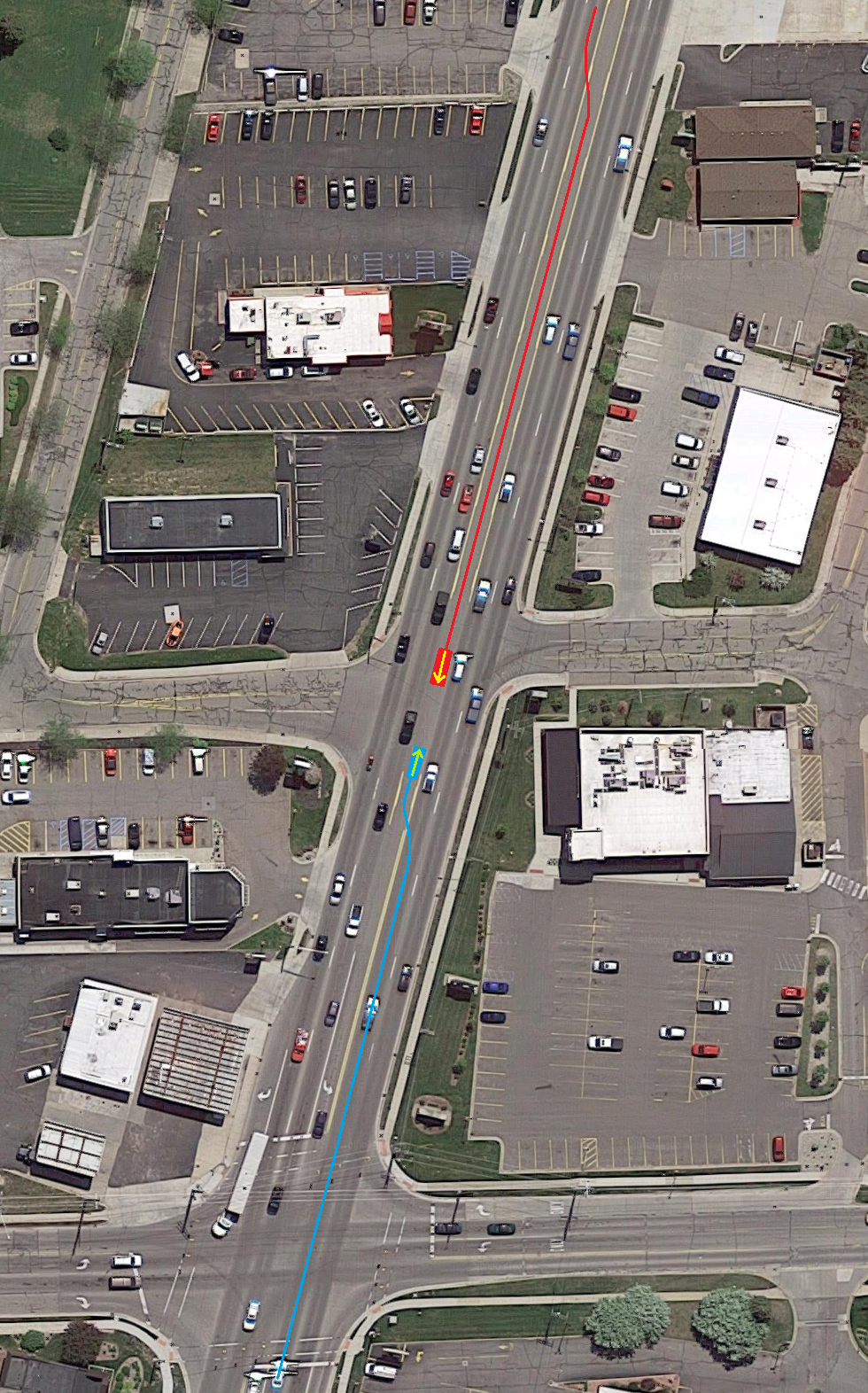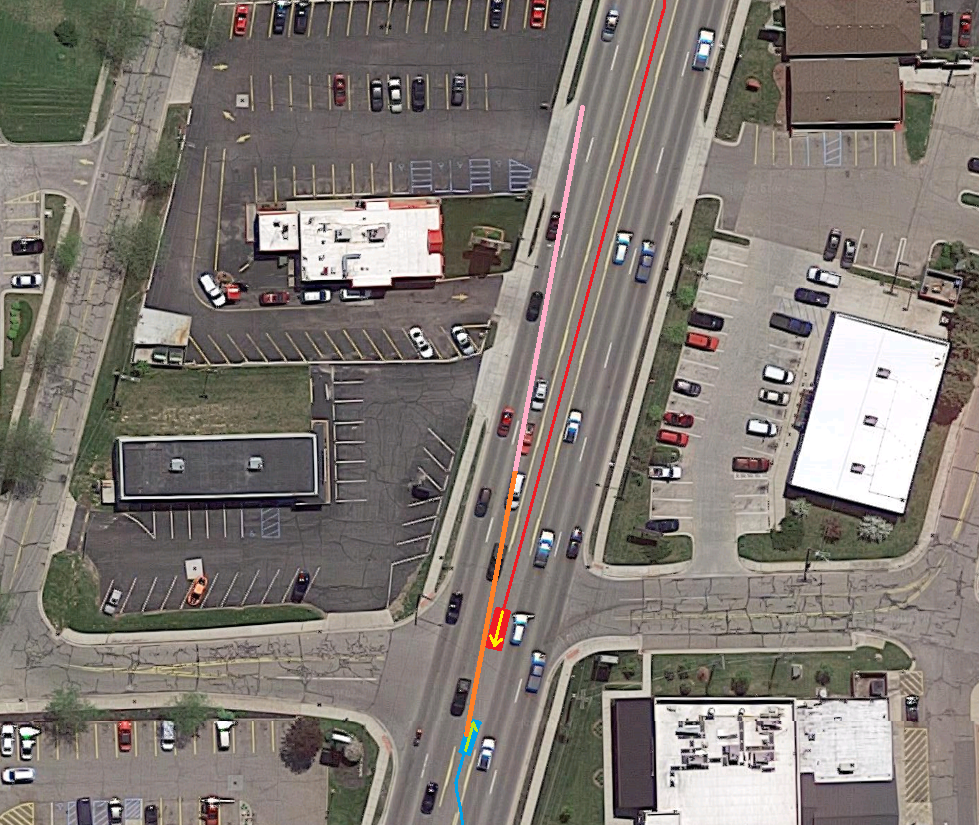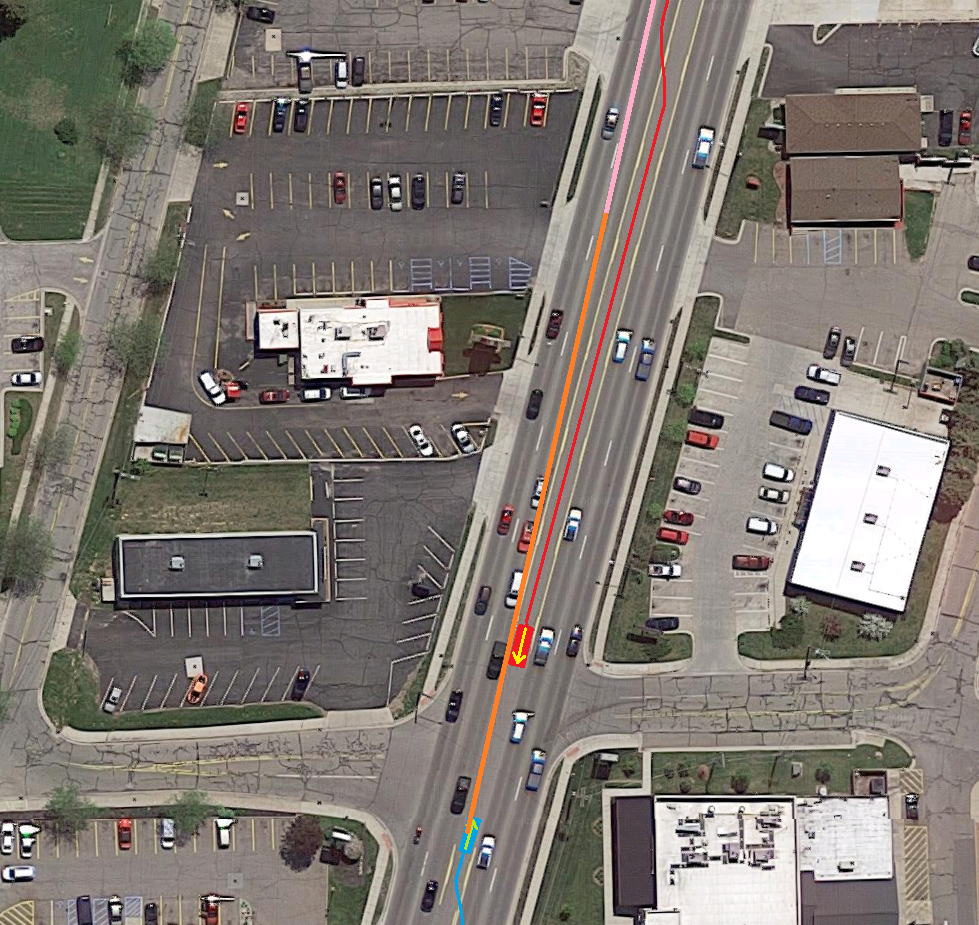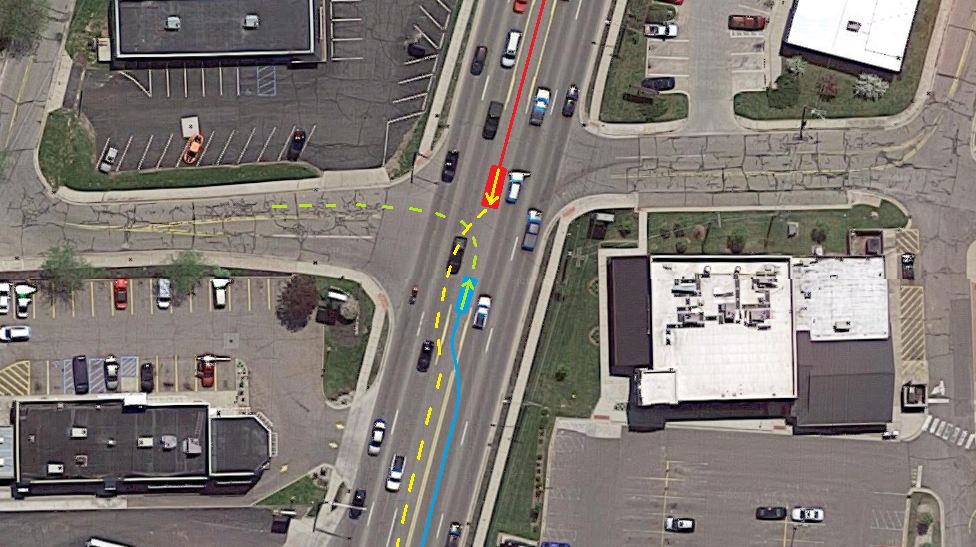 "Urambo Tauro" (urambotauro)
"Urambo Tauro" (urambotauro)
03/14/2019 at 11:00 • Filed to: visibility is important, visibility, turn lanes, driving
 1
1
 2
2
 "Urambo Tauro" (urambotauro)
"Urambo Tauro" (urambotauro)
03/14/2019 at 11:00 • Filed to: visibility is important, visibility, turn lanes, driving |  1 1
|  2 2 |

There’s a lot to be said about different facets of visibility, but I wanted to share this recent encounter as its own example.
This happened as I was waiting to turn left onto a side street. Study the image above. The blue box and line represent my car and the path it came from. The red box and line represent an opposing pickup truck and the path it came from.
So. I had a left turn to make. I signaled and took what I believe to be the best line into the center turn lane, respecting the position of the double-yellow lane markings and oncoming traffic’s exclusive right to use of that turn lane beyond a certain point.
Traffic was moderately heavy, and as the light at the intersection behind me turned red, oncoming traffic was slowing down to make their stop. Hopefully they would stop in a manner that left enough room for me to make my turn. If not, well, I would have to wait until the next cycle.
Unfortunately, no one felt like letting me slip through before they stopped for their red light. Each time I thought I was about to get an opening, the deceleration rate of the oncoming car changed my mind. Sure enough, they all came to a stop directly in the intersection. Welp, maybe the next cycle I’ll get a chance...
As traffic backed up in those oncoming lanes, some guy in a lifted truck behind them decided that approximately 15 cars was too long of a line to wait behind. His goal? To turn left at the light behind me .
Boy was he disappointed when he found me in “his” lane.
I gave him the benefit of the doubt at first, assuming that perhaps he was turning into a nearby side street or driveway, but as he got closer and passed the last of those valid options, his intentions became clear.
The line of cars that he was attempting to bypass was too dense for him to easily retreat back into his proper lane, so he decided to creep forward until he was about 1.5 car-lengths away from me. As if that would help.
Of course, when the light behind me turned green, oncoming traffic was more keen about making it through that green light themselves than they were about letting me through. Can’t blame them; that’s how right-of-way works.
Naturally, the pickup driver’s previously-abandoned place in that line of traffic had been filled by this point, and as those cars passed him by, he became further and further “behind” than where he would have been if he hadn’t jumped into the turn lane so early.
As near as I could tell, oncoming traffic was beginning to clear up... But the truck was so close that I actually couldn’t see very far ahead. I had a decent view of the oncoming curb lane, but the near/inside lane- not so much. Each time I thought I was about to get my opportunity to turn, another car suddenly appeared from around the front corner of his truck, moving somewhere in the neighborhood of the 40 mph speed limit, give or take.
Here’s another visualization to illustrate my line of sight:

The orange line here is just to show how far I could see vehicles approaching in the near lane. It does not necessarily represent a “go-or-no-go” point.
This is the right edge of my view of oncoming traffic, as compromised by the front corner of the opposing truck (red). The orange portion of the line shows an approximation of how close a vehicle in the nearest oncoming lane needed to be before I could see it. (It’s actually worse than that when you consider that a motorcycle could be hiding in the hidden half of that lane...)
No matter how empty the curb lane looked, I couldn’t blindly trust the near lane. Somebody could legitimately be in that lane intending to enter the turn lane behind me, and besides- there are too many left-lane hogs around these parts anyway.
The only way to get a better look around the view-obstructing truck would have been to start driving
into
the near oncoming lane. NOPE, not falling for that. I need to ensure that BOTH oncoming lanes are clear BEFORE making my move. We’ve all seen those videos...
I strained my neck in an effort to see around the truck, but it didn’t help much. Especially since his truck was lifted and I was in a Mustang.

IF ONLY: If the truck had held back like this, as if to turn left onto the nearby side street, I would have had more than 300 ft of visibility down the near oncoming lane, and even more down the curb lane. Again, orange represents my view of cars in the near lane, not necessarily the actual “go-or-no-go” zone.
Now, under normal circumstances, a vehicle facing me in that center turn lane would have been further away, waiting to make their own left turn onto that side street. But this guy had cut that distance by more than half. He still wasn’t
in my way
path-wise though; the problem was that he was blocking my view.
Even if oncoming traffic was to clear up, I wouldn’t be able to see the opening. There would seem to be an absence of cars, but at any given moment another one could pop out from around that truck, and wreck my day. As long as that truck was blocking my view, the only way I’d be able to ensure a safe path across those oncoming lanes, would be for oncoming traffic to arrive and STOP where I could see them.
As I continued to wait, I avoided making eye contact with the pickup driver. The speed at which he had jumped into the turn lane, and his pointless gesture of creeping up closer to my car gave me the sense that he was an aggressive driver. So instead on engaging him in any way, I kept craning my neck in as obvious a manner as I could, so that if he was looking, he would see me struggling to see around his truck. I’ll never know if he got that message, but it was all I could do. I was stuck .
Eventually, he apparently saw a big enough opening in his own mirrors to return to his lane, get around me, and slip back into the turn lane. FINALLY, I was free to see a break in oncoming traffic and make my turn. Here’s one more visualization, the broken green and yellow lines showing the paths we took after “facing off”:

The encounter felt like it took forever. I probably missed a couple of legit opportunities to make my turn, but I just couldn’t see them. Every time I started to feel like I was hesitating too long, another car popped out from around that truck’s fender at speed , confirming that I was making the right call. My only regret is that my stupid dashcam didn’t capture any of it. (Actually, it would have looked worse on dashcam, since its line of sight starts from the center of the car.)
Yeah, I probably could have titled this post “Why You Shouldn’t Enter the Center Turn Lane Too Early”. There are certainly a lot of things to be said about the proper way to share a center turn lane with oncoming traffic, and that’s a discussion that needs to happen. But I’ve been thinking a lot about visibility lately, and this just hit me as a good example of why it’s so important.
 Just Jeepin'
> Urambo Tauro
Just Jeepin'
> Urambo Tauro
03/13/2019 at 18:06 |
|
Completely different scenario, but that reminds me of a situation I’ve contemplated in the past.
Intersection where one road has to stop, other does not. You’re waiting to turn left, the traffic coming from the opposite direction is consistently going straight through (after stopping of course).
Who has the right of way? People going straight or you, since you were there first?
Update : to clarify, this is important if there’s enough cross traffic that you can’t both proceed. Theoretically you can be stuck waiting forever if you have to wait both for cross traffic and for the people traveling towards you.
 Urambo Tauro
> Just Jeepin'
Urambo Tauro
> Just Jeepin'
03/13/2019 at 18:24 |
|
In my state, it’s still “stop first, go first”.
However, there may be some instances where there the gap in traffic might be too small for the (first to stop) left-turner to jump out and get up to speed without cutting off traffic , whereas that same gap might be big enough for straight-across traffic to zip across. In such a case, I would argue that the (second to stop) straight-across traffic is not actually interfering with the left-turner’s apparent right-of-way, because the left-turner does not yet have R-O-W to proceed due to the cross traffic . It’s a fine line though, and requires careful timing, as well as attention to road conditions and familiarity with the car’s ability to accelerate.
!!!error: Indecipherable SUB-paragraph formatting!!!